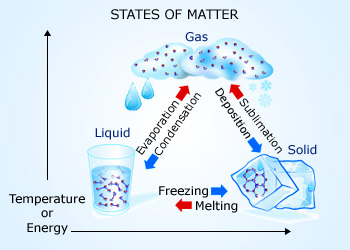 Transforming matter
Matter exists in three different states at room temperature. These are solid, liquid and gaseous states. The three states of the matter are inter-convertible when heat is supplied or removed from molecules. For example, water at ordinary temperature is liquid. But if we cool it, it becomes ice and on heating it gives steam.
Transforming matter
Matter exists in three different states at room temperature. These are solid, liquid and gaseous states. The three states of the matter are inter-convertible when heat is supplied or removed from molecules. For example, water at ordinary temperature is liquid. But if we cool it, it becomes ice and on heating it gives steam.
Two other forms also exist at extreme temperatures. These are plasma and Bose–Einstein condensate that occur at a very high (105K) and very low (<10–7 K) temperatures respectively.
All substances around us consist of matter. Matter is anything that occupies space and has mass. The blackboard in the classroom, the chair that you are sitting on, the air you breathe, the food you eat, the plate and spoon, etc., are all made up of matter. All living and non–living objects-everything is made up of matter!
What do you first observe about matter? Our perception and understanding of everything around us is through our five different sense organs-eyes, nose, ears, tongue and skin. We see that matter comes in various colors, smells, textures, temperatures etc. Edible matter comes in various tastes and if you hit various objects, they make many different sounds. The variety of matter is immense and exist in various states. In addition, matter (or substances) can be either pure or a combination of two or more substances. For example, water may be a pure liquid, but salt solution is a combination of water and salt.
Besides these properties, matter, as seen in everyday life, comes in three primary states: solid, liquid and gas. The simplest observation is water cycle. Water as rain is liquid and as hail is solid. The third state is the invisible water-vapour (steam) due to evaporation by Sun rays.
Heat plays a crucial role in transforming matter from one state into another. Each transformation has a specific name and purpose (refer adjacent image). For example, a solid can be transformed into liquid by a transformation process, melting. In addition, matter (or substances) can be either pure or a combination of two or more substances. For example, water may be a pure liquid, but salt solution is a combination of water and salt.